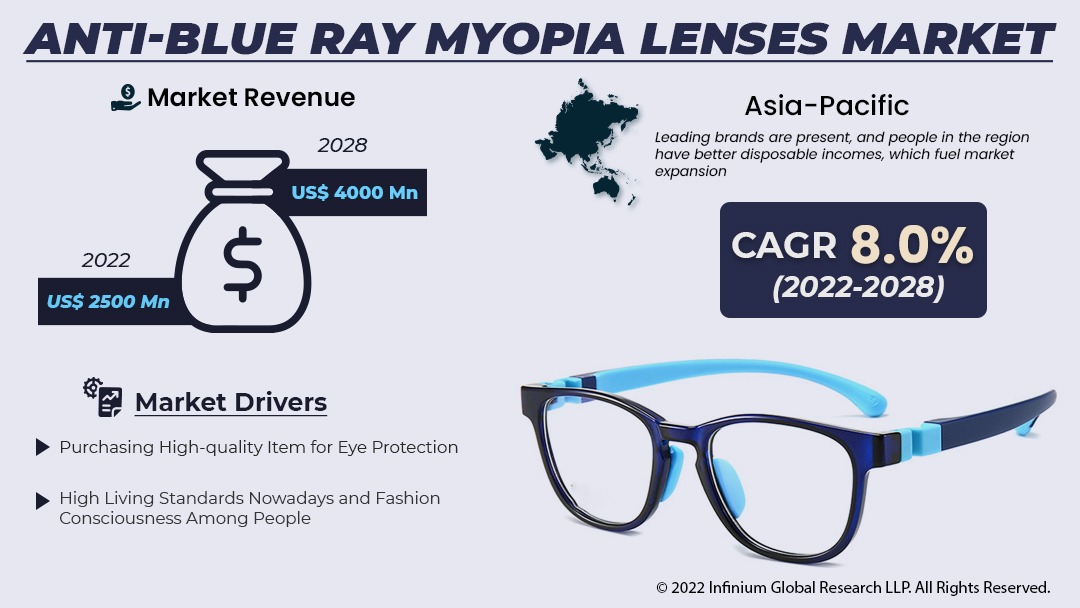Anti-blue Ray Myopia Lenses Market (Type - Single, Bifocal, and Trifocal; Application - Improve Vision, and Vision Correction; Distribution Channel - Retail Stores, Hospitals & Clinic, and E-commerce): Global Industry Analysis, Trends, Size, Share and Forecasts to 2028
A recent report published by Infinium Global Research on the anti-blue ray myopia lenses market provides an in-depth analysis of segments and sub-segments in the global as well as regional anti-blue ray myopia lenses market. The study also highlights the impact of drivers, restraints, and macro indicators on the global and regional anti-blue ray myopia lenses market over the short term as well as long term. The report is a comprehensive presentation of trends, forecasts, and dollar values of the global anti-blue ray myopia lenses market. According to the report, the global anti-blue ray myopia lenses market is projected to grow at a CAGR of Over 8% over the forecast period of 2022-2028.
Market Insight
The global anti-blue ray myopia lenses market was valued at nearly USD 2500 million in 2022 and is expected to reach about USD 4000 million in 2028, with a CAGR of Over 8% during the forecast period. Blue-ray-resistant myopia lenses to stop damaging blue light rays from reaching the eyes. Glasses that block blue light are used. The blue light rays from the screen are blocked by their yellow-tinted filter, which keeps them from entering the eyes. These lenses provide anti-glare defense. These lenses will reduce the likelihood of eye damage and the recurrence of computer vision syndrome symptoms. Myopia, or short-sightedness, is a well-known term. This is spreading around the world as a result of rising screen usage. This illness is spreading globally with certain variants. By 2050, myopia will afflict more than half of the world's population, making it the most prevalent ailment. By easing eye discomfort, anti-blue ray myopia lenses can lessen eye strain. The companies that make anti-blue ray myopia lenses also employ successful marketing techniques to introduce cutting-edge products in order to grow their market share. Digital eye strain and computer vision syndrome may be brought on by excessive usage of digital devices. For reducing eye strain and enhancing concentration blue-ray-blocking lenses are employed.
The demand for high-quality eyewear is what fuels the expansion of the anti-blue ray myopia lenses market globally. By using the terms nearsightedness and shortsightedness as well as an impairment of eyesight called myopia causes a fuzzy image. The use of digital gadgets including laptops, tablets, cellphones, and e-readers has become commonplace. The corneal reflex in the eye may become less responsive when using contacts. When something could directly harm the eyes, such as a flying object or someone poking into the eye, the corneal reflex guarantees that the person closes their eyes. Anti-blue ray lenses are found to turn yellow over time due to the usage of certain chemicals in the lens that is manufacture process; this is referred to as a restraining factor. Given the high standards of living in society today and the growing interest in fashion, the industry is likely to benefit from the growing popularity of online virtual try.

In 2021, Asia Pacific will dominate this market, with countries like China, India, and Japan among the Asian countries represented. Children's myopia is getting increasingly prevalent. Leading brands are present, and people in the region have better disposable incomes, which fuel market expansion. Over the past 60 years, myopia has been rapidly rising among youngsters in Southeast Asia, which has an impact on the academic performance of schoolchildren. NCBI conducted this analysis (National Center of Biotechnology Information). Based on these research, the Asia Pacific anti-blue ray myopia lenses market anticipates an increase in demand for these lenses.
Segment Covered
The report on the global anti-blue ray myopia lenses market covers segments such as type, application, and distribution channel. On the basis of type, the sub-markets include single, bifocal, and trifocal. On the basis of application, the sub-markets include improve vision, and vision correction. On the basis of distribution channel, the sub-markets include retail stores, hospitals, clinic, and e-commerce.
Companies Profiled:
The report provides profiles of the companies in the market such as Pinterest, Hoya Corporation, Rodenstock GMBH, Nikon Corporation, Shamir Ltd., GLASSESLIT, Ocuco, Seiko Watch Corporation, CHEMIGLAS CORP., Essilor International.
Report Highlights:
The report provides deep insights into demand forecasts,
market trends, and micro and macro indicators. In addition, this report
provides insights into the factors that are driving and restraining the growth
in this market. Moreover, The IGR-Growth Matrix analysis given in the report
brings insight into the investment areas that existing or new market players
can consider. The report provides insights into the market using analytical
tools such as Porter's five forces analysis and DRO analysis of anti-blue ray
myopia lenses market. Moreover, the study highlights current market trends and
provides forecasts from 2022-2028. We also have highlighted future trends in the
market that will affect the demand during the forecast period. Moreover, the
competitive analysis given in each regional market brings insight into the
market share of the leading players.
